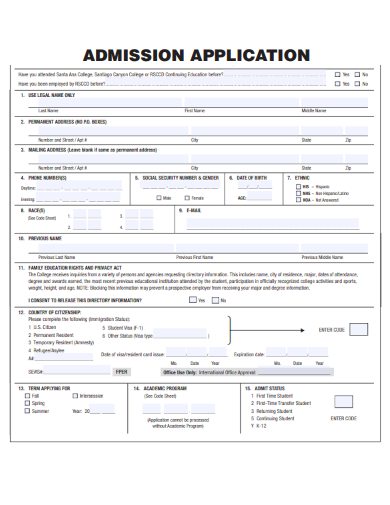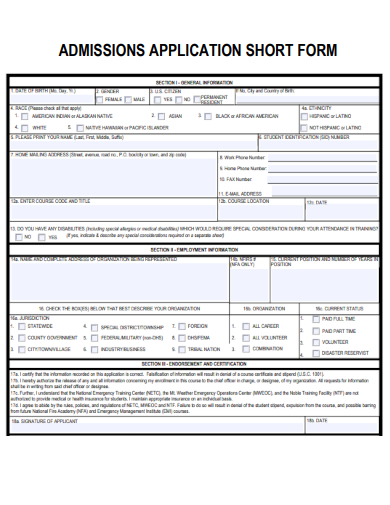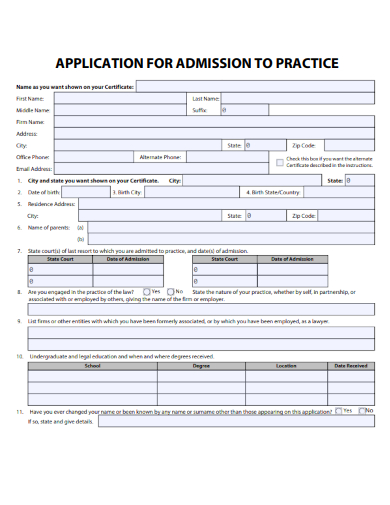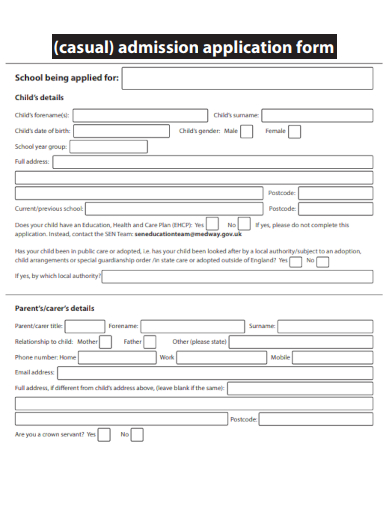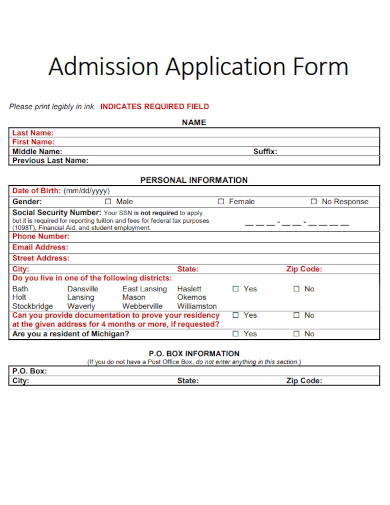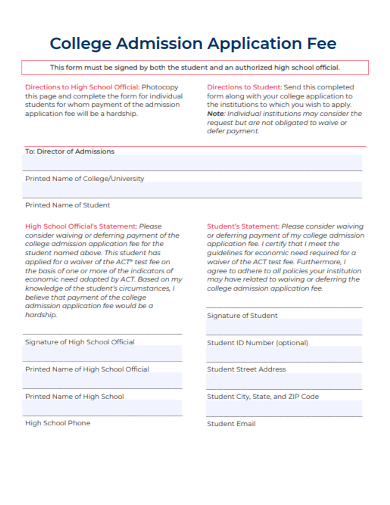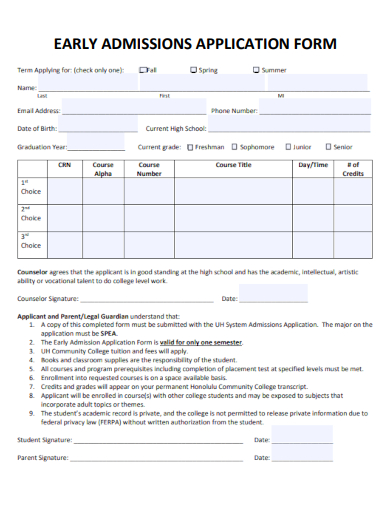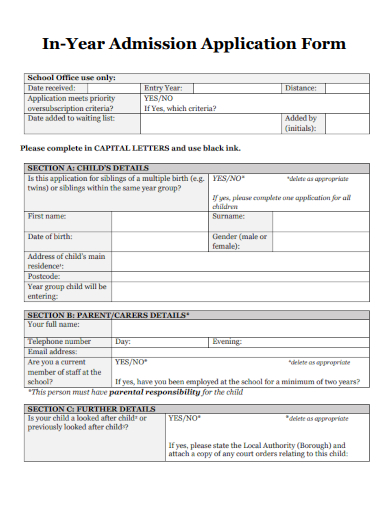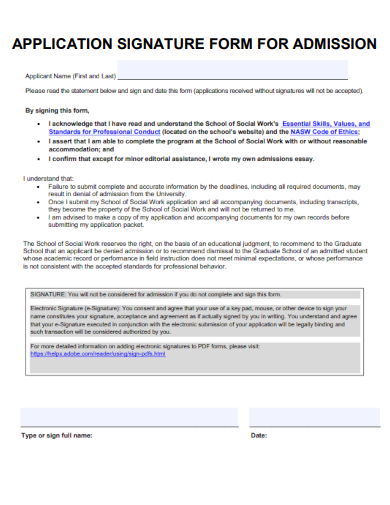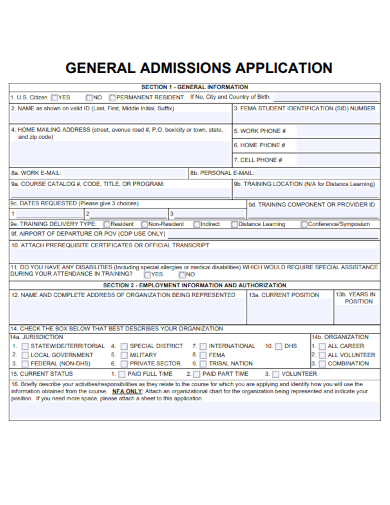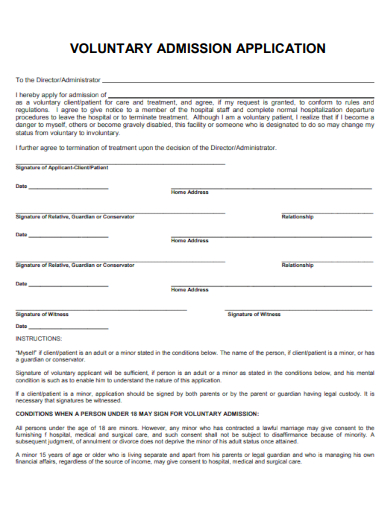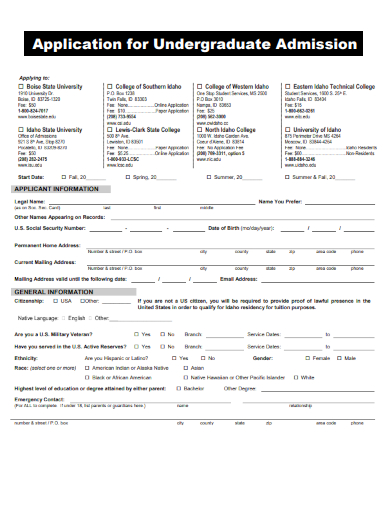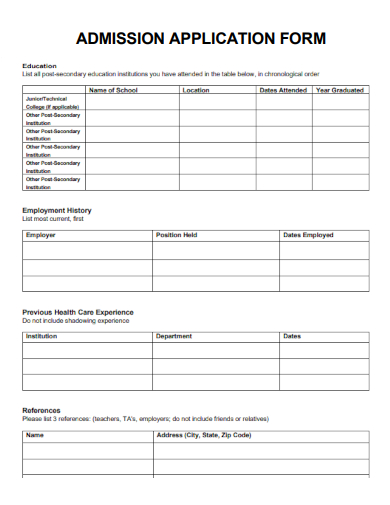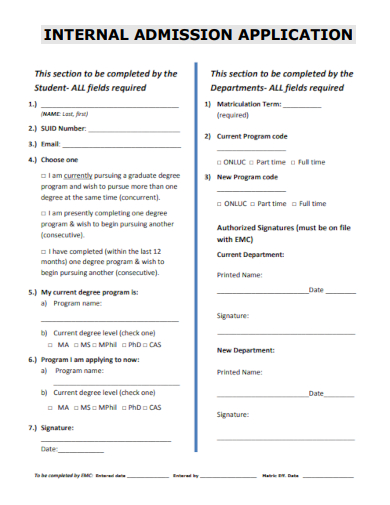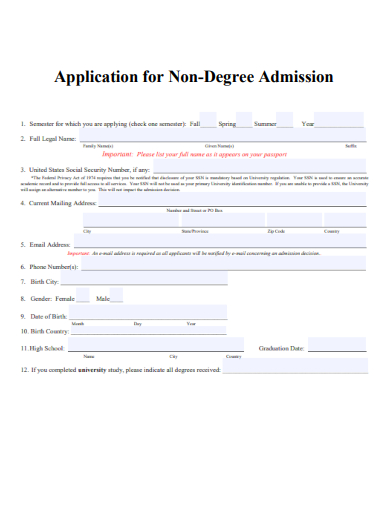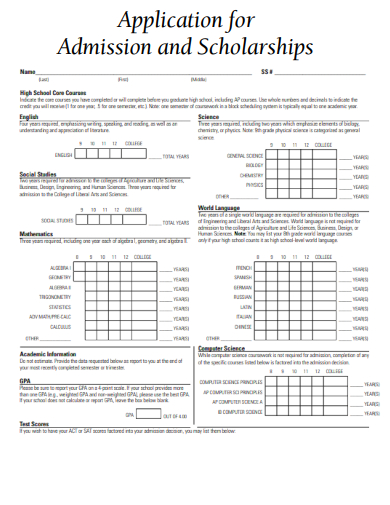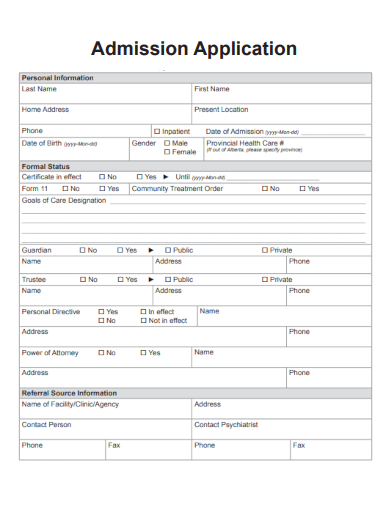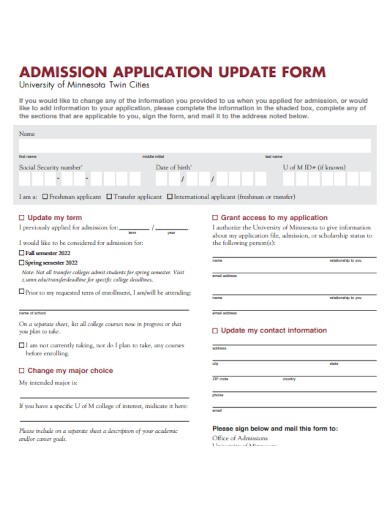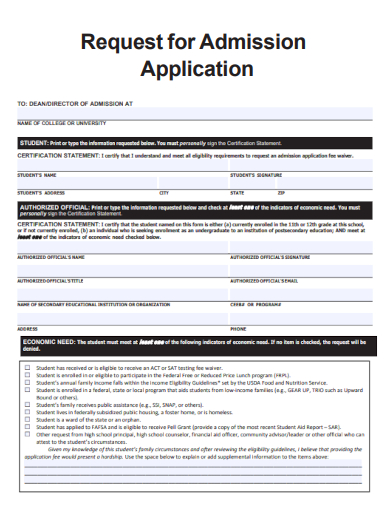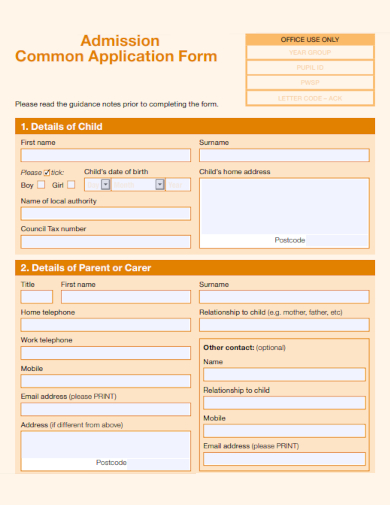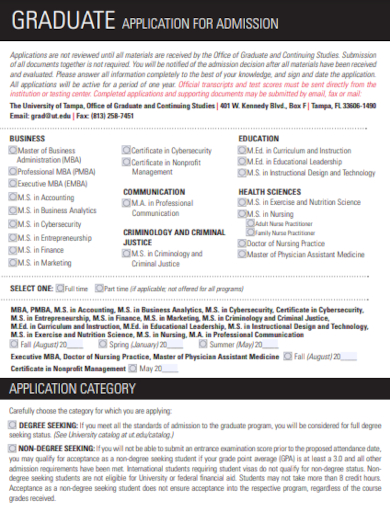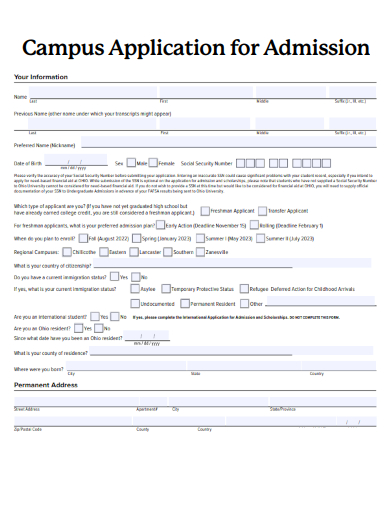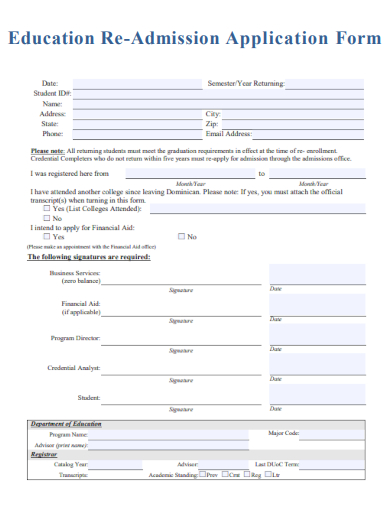Unlock the doors to a brighter future with our comprehensive Admission Application form! Expertly tailored to capture your unique academic journey, this form is your passport to premier educational experiences. Whether you’re a budding scholar or a passionate learner, navigate seamlessly through our user-friendly interface. Dive in, submit, and get closer to turning your educational dreams into reality. Enroll, excel, and elevate with us!
FREE 37+ Admission Application Form Samples
1. Sample School Admission Application Form Template
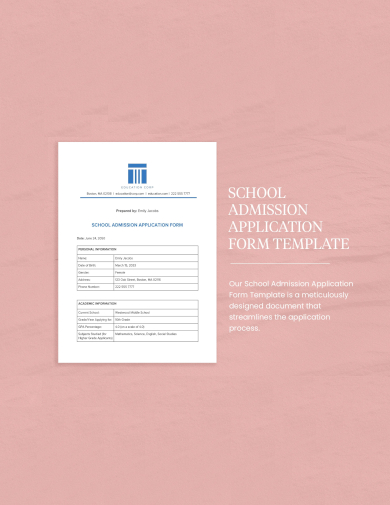
2. Sample Admission Application Form Template
3. Sample Admission Application Short Form Template
4. Sample Application for Admission to Practice Form Template
5. Sample Casual Admission Application Form Template
6. Sample Student Admission Application Form Template
7. Sample Admission Application Form Basic Template
8. Sample College Admission Application Fee Form Template
9. Sample Early Admission Application Form Template
10. Sample In-Year Admission Application Form Template
What is an Admission Application Form?
An admission application form is a pivotal document used by educational institutions to gather essential information from prospective students. This form is the primary gateway for aspirants looking to join schools, colleges, universities, or specialized courses.
Purpose and Importance
The primary purpose of an admission application form is to collect pertinent details about a candidate to facilitate the admission process. This data aids institutions in:
Assessing Suitability: Understanding if the candidate meets the prerequisites or has the aptitude for a particular course or program.
Maintaining Records: For administrative purposes, having a standardized set of information on every student is invaluable.
Streamlining the Selection Process: By having a consistent format, institutions can efficiently compare applicants.
Key Elements
While the specifics might vary, most admission application forms share some common components:
Personal Details: Information like name, date of birth, gender, and contact details.
Academic History: Previous institutions attended, grades obtained, certifications, and other achievements.
Course Preferences: The specific course or major the applicant is interested in.
Extracurricular Activities: Details of any non-academic interests, hobbies, or skills.
References: Often, institutions require recommendations or references from former teachers or professionals.
Personal Statement: A section where applicants can describe their motivations, aspirations, and reasons for choosing a particular course or institution.
How Do I Draft an Admission Form?
Drafting a comprehensive admission form requires a methodical approach, ensuring it is both detailed yet user-friendly.
Start with the Basics
Identify the primary information you need:
Personal Details: This includes names, contact information, nationality, and any other relevant personal data.
Course or Major Selection: Provide a dropdown or checklist of available courses for ease of selection.
Delve into Academic Details
This is the core of the admission form:
Education History: Create sections for school, undergraduate, postgraduate, or other qualifications, as applicable. This should include the name of the institution, years attended, and grades obtained.
Certificates and Achievements: Allow space or an option to upload any relevant certifications.
Incorporate Additional Activities
Extracurricular Section: This can be broken down into sports, arts, clubs, or any other categories relevant to your institution.
Volunteer Work or Internships: An area where applicants can detail any unpaid or work experiences.
Personal Statement or Essay
Depending on the level of study:
Guidelines: If you require an essay or personal statement, clearly state the word limit and provide prompts or questions the applicant should address.
References
Details and Format: Clearly mention how many references you require and in what format (letters, contact details for verification, etc.).
Design and User Experience
A well-designed form can make the process smoother for applicants:
Logical Flow: Group related fields together to make the form intuitive.
Instructions: Provide clear instructions for each section, especially if you have specific requirements for attachments or essays.
Mobile Responsiveness: Ensure the form is easily accessible and fillable on mobile devices.
Privacy and Data Protection
Given that applicants share personal and sensitive information:
Privacy Statement: Assure applicants that their data will be protected and not shared without consent.
Secure Platform: If your form is online, use a platform known for data security.
a well-drafted admission application form not only streamlines the administrative process for institutions but also makes the application journey simpler and clearer for students. Ensure that your form is comprehensive, user-friendly, and secure, setting the foundation for a positive educational relationship.
11. Sample Application Signature Form for Admission Template
12. Sample General Admission Application Form Template
13. Sample Voluntary Admission Application Form Template
15. Sample Application for Undergraduate Admission Form Template
16. Sample Admission Application Form Standard Template
17. Sample Internal Admission Application Form Template
18. Sample Application for Non-Degree Admission Form Template
19. Sample Application for Admission & Scholarships Form Template
20. Sample Admission Application Form Editable Template
21. Sample Admission Application Update Form Template
22. Sample Request for Admission Application Form Template
23. Sample Admission Common Application Form Template
24. Sample Graduate Admission Application Form Template
25. Sample Campus Application for Admission Form Template
26. Sample Education Re-Admission Application Form Template
How to Create an Admission Application Form?
Creating an efficient admission application form is essential for a smooth and transparent selection process. This guide walks you through the intricacies of designing a form that gathers all necessary information while maintaining user-friendliness.
Step 1: Determine the Purpose
Scope of the Form: Understand if the form caters to undergraduate, postgraduate, or other specific programs.
Target Audience: Recognize the demographics of your potential applicants. International students might require additional fields like visa status or language proficiency tests.
Step 2: Choose a Format
Paper vs. Digital: While paper applications are traditional, many institutions are shifting to digital for efficiency and eco-friendliness. Platforms like Google Forms, Typeform, and specialized admission software can be considered for online formats.
Step 3: Structuring the Form
Personal Details: Start with basic details – name, date of birth, address, contact information.
Academic History: Create sections for previous academic records, from high school onwards, including grades and any special achievements.
Program Selection: Have a clear section where applicants can choose their desired course or major.
Extracurriculars and Achievements: Space for applicants to list hobbies, sports, arts, or other non-academic pursuits.
Personal Statement/Essay Prompts: If needed, add a section with clear guidelines on length, topics, and format.
Step 4: Design Elements
Navigation: If digital, ensure the form is easy to navigate, with logical sections and clear instructions.
Accessibility: Ensure compatibility across devices, especially mobiles and tablets.
Save and Return: Allow applicants to save their progress and return, as they might not complete the form in one go.
Step 5: Data Security and Privacy
Confidentiality: Assure applicants that their information will remain confidential and won’t be used for unsolicited purposes.
SSL Encryption: If online, utilize platforms offering SSL encryption to protect the data during transmission.
Step 6: Review and Feedback
Pilot Test: Before making the form live, conduct a trial run with a smaller group to gather feedback and understand potential pain points.
Refinement: Use the feedback to make any necessary tweaks and refinements.
What is Admission and Application?
The terms “admission” and “application” are frequently used interchangeably in the educational context, but they have distinct meanings and implications.
Understanding “Application”
An application is the process or act of submitting necessary documents, forms, and other requirements to express interest in joining an educational institution or program.
Components: This generally includes personal details, academic records, letters of recommendation, personal essays, and sometimes, test scores or portfolios.
Purpose: It serves as the first step for students to showcase their eligibility and interest in a specific program or institution.
Delving into “Admission”
Admission refers to the approval or acceptance of a student’s application by an educational institution, granting them the right to enroll and attend classes.
Criteria: Admissions are typically based on the evaluation of the application materials, performance in entrance exams (if any), interviews, and sometimes, additional criteria like extracurricular activities.
Outcome: Once admitted, students receive formal communication, usually an acceptance letter, detailing the next steps for enrollment.
Interplay between Application and Admission
While these terms are distinct, they are interconnected stages of the enrollment process.
Application Phase: Students research potential institutions, fill out forms, gather required materials, and submit their applications before deadlines.
Evaluation Phase: Institutions review these applications, considering academic qualifications, personal statements, recommendations, and other criteria.
Admission Phase: Post-evaluation, institutions offer admissions to selected candidates, who then decide whether to accept the offer and enroll.
while “application” and “admission” are related, they mark different stages in the journey of a student towards securing a spot in an educational institution. Recognizing the difference can help streamline both processes and ensure clarity for all involved parties.
Related Posts
Parent Consent Form Samples & Templates
Sample Release of Liability Forms
Sample Training Feedback Forms
Sample Sworn Affidavit Forms
Agreement Form Samples & Templates
Vehicle Inspection Forms Samples & Templates
Sample Employee Advance Forms
Sample Child Travel Consent Forms
Sample Testimonial Request Forms
Sample Employee Details Forms
Sample Divorce Forms
Sample Attestation Forms
Employee Performance Appraisal Form Templates
FREE 9+ Sample Presentation Evaluation Forms in MS Word
FREE 10+ School Admission Form Samples & Templates in MS Word | PDF

